The Village Weaver, a captivating bird species native to sub-Saharan Africa, enthralls with its intricate nest-building abilities and vibrant social dynamics.
Renowned for crafting complex nests that adorn tree branches like natural ornaments, these birds showcase remarkable adaptability and resourcefulness in their construction methods.
Despite their small size, Village Weavers captivate with their unique behaviors and striking appearance, earning respect and admiration from bird enthusiasts.
Their close association with human settlements, often found in rural communities or farmsteads, highlights their ability to thrive alongside humans.
This proximity offers an intimate glimpse into their fascinating habits and lifestyle, underscoring the bond between these feathered architects and their human neighbors.
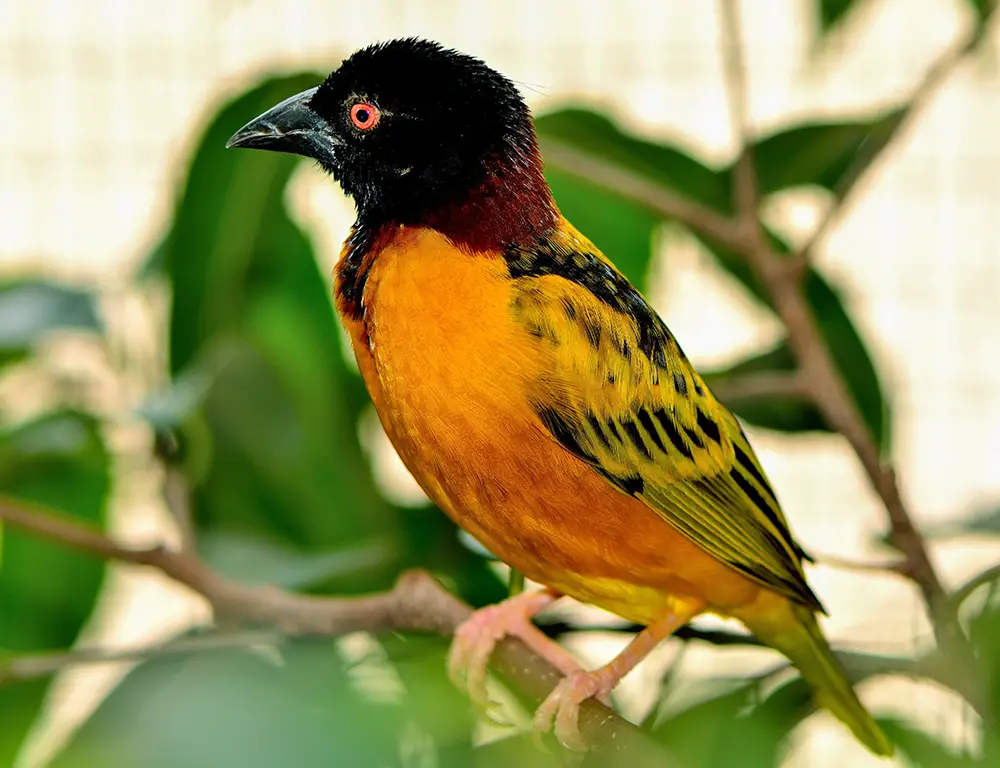
Habitat and Distribution of Village Weaver
The Village Weaver (Ploceus cucullatus) is a bird species native to sub-Saharan Africa, known for its adaptability to various habitats and wide geographic distribution.
Here’s an overview of their habitat and distribution:
Geographic Range
The Village Weaver is broadly distributed across sub-Saharan Africa, from West to South Africa. They are particularly prevalent in regions such as West Africa, stretching towards Central and Southern Africa.
This distribution encompasses a variety of countries, including but not limited to Nigeria, Ghana, Cameroon, Kenya, Tanzania, Zambia, and South Africa.
Habitat
Village Weavers exhibit versatility in their habitat preferences, inhabiting various environments across their geographic range. They can be found in the following habitats:
- Grasslands: Village Weavers are commonly found in grassland habitats, where they utilize grasses and other vegetation for nesting materials and foraging opportunities. These open landscapes provide suitable conditions for their feeding and breeding activities.
- Savannahs: The open savannahs of Africa also serve as habitats for Village Weavers, offering ample opportunities for foraging and nesting.
These habitats provide a mix of grasses, shrubs, and scattered trees, which support the birds’ diverse ecological needs. - Forest Edges: Village Weavers inhabit forest edges and woodland areas, where they can find food resources and nesting sites. These habitats offer protection from predators and diverse food sources, contributing to the birds’ survival.
- Agricultural Fields and Plantations: Despite human presence, Village Weavers are often found in agricultural landscapes and plantations, including fields of crops such as rice, maize, and sugarcane.
These areas provide abundant food resources, including seeds and insects, although they may face habitat alteration and pesticide use challenges.
Physical Characteristics of Village Weaver
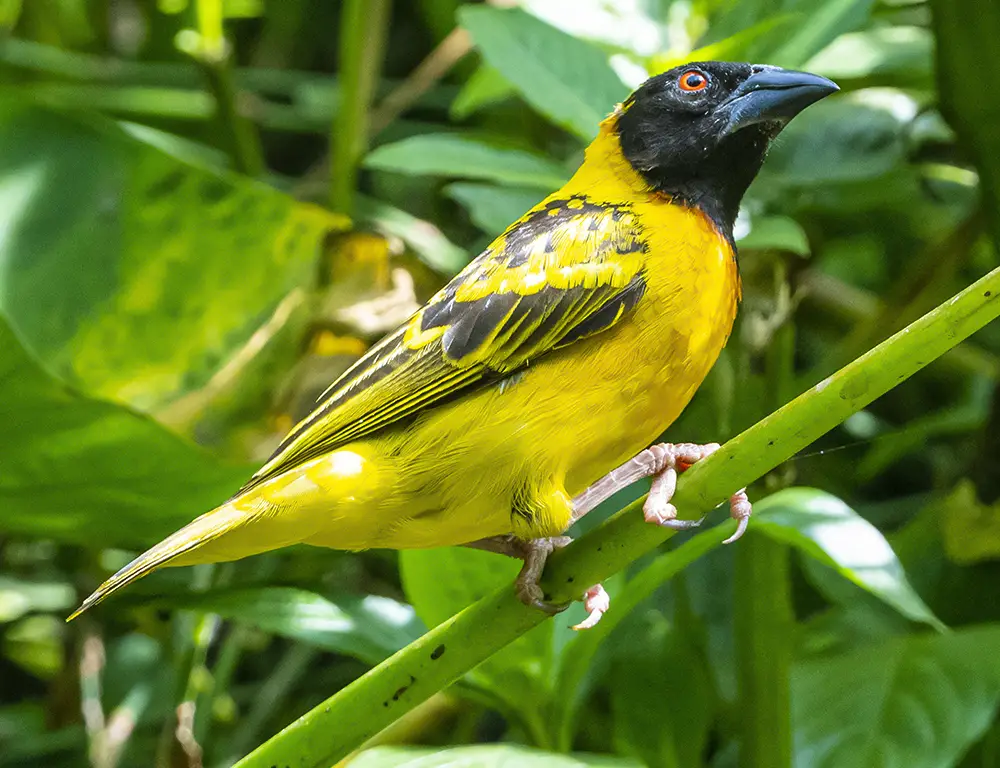
The physical characteristics of the Village Weaver (Ploceus cucullatus) contribute to its distinct appearance and functional adaptations for survival in its natural habitat. Here’s an overview:
Size
Village Weavers are small to medium-sized birds, with adult males typically measuring between 15 to 17 centimeters (about 6 to 7 inches) in length. At the same time, females are slightly smaller, ranging from 14 to 16 centimeters (about 5.5 to 6.3 inches).
Plumage
The plumage of the Village Weaver exhibits sexual dimorphism, with males displaying more vibrant colors than females, especially during the breeding season.
Male Village Weavers feature bright yellow underbellies and rich black heads, which are distinctive markings.
Outside of the breeding season, males adopt a more subdued appearance like females, which maintains an olive-green tone year-round.
Feathers
The feathers of Village Weavers are tightly packed and smooth, providing insulation and protection from varying climatic conditions in their habitats.
Their dense feathering also aids in maintaining body temperature and waterproofing, which is essential for survival in diverse environments.
Beak
Village Weavers have strong, conical beaks well-suited for their granivorous diet, primarily of seeds.
Their beaks are adapted for cracking open seeds and extracting their contents, allowing them to access food resources in their environment efficiently.
Legs
These birds possess short, sturdy legs, crucial for perching, hopping, and navigating through their habitats, including tree branches and grasslands. Their legs provide stability and agility, facilitating foraging activities and evading potential predators.
Body Shape
Village Weavers have compact, streamlined bodies, which enable swift movement through dense foliage and grasslands where they often reside. Their aerodynamic body shape contributes to their agility and maneuverability, aiding in flight and predator avoidance.
Diet and Feeding Habits of Village Weaver
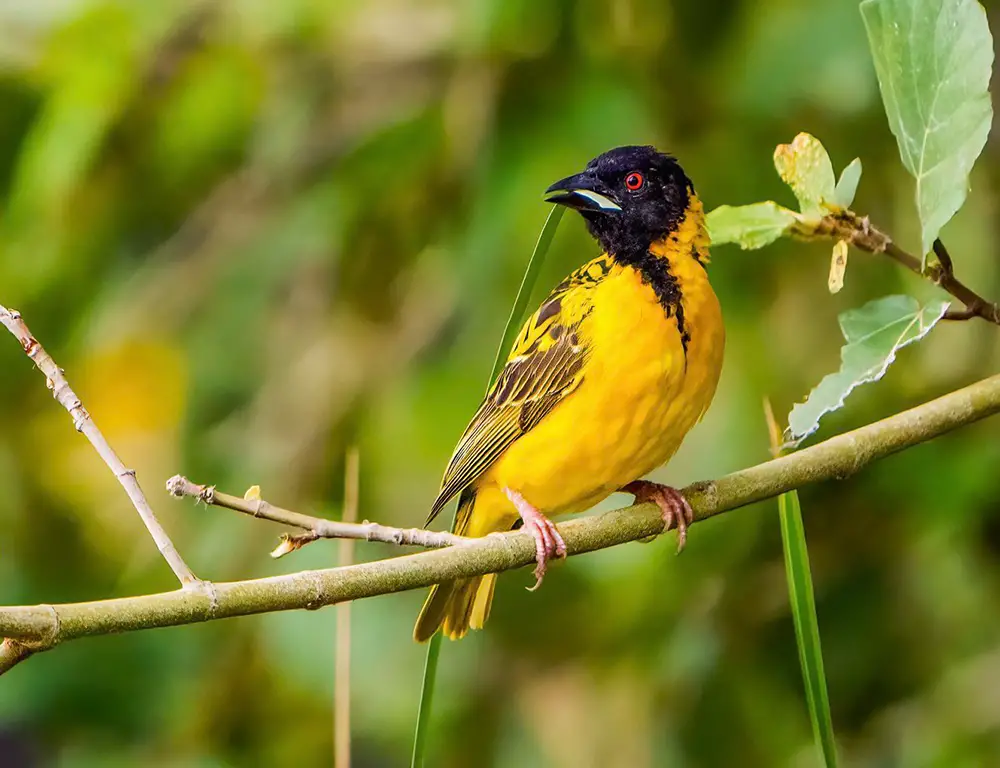
The Village Weaver (Ploceus cucullatus) is primarily a granivorous bird, meaning its diet primarily consists of grains and seeds. However, their feeding habits can vary depending on factors such as habitat, seasonal availability of food, and reproductive needs.
Here’s a closer look at the diet and feeding habits of Village Weavers:
Seed Preferences
Village Weavers have a particular affinity for various seeds, with wild grass seeds being a primary diet component. They are known to consume seeds from a range of plant families, including:
- Poaceae (Grasses): Grass seeds are a staple food source for Village Weavers. They forage for seeds from various grass species in their habitats, including wild and cultivated grasses.
- Fabaceae (Legumes): Village Weavers may also feed on seeds from leguminous plants within the Fabaceae family. These seeds provide additional nutritional resources and contribute to the birds’ dietary diversity.
- Asteraceae (Sunflowers): Seeds from plants within the Asteraceae family, such as sunflowers and other flowering plants, may also be consumed by Village Weavers, mainly when available in their habitats.
Foraging Behavior
Village Weavers exhibit specialized foraging behaviors tailored to their seed-based diet. They typically forage for seeds while perched on vegetation or occasionally hop along the ground for food.
They extract seeds from grass heads and other seed-bearing structures using their sharp, conical beaks.
During certain times of the year, such as the breeding season, Village Weavers may supplement their seed-based diet with insects.
This dietary flexibility allows them to adapt to changing food availability and nutritional requirements, ensuring their survival and reproductive success.
Impact of Human Activities
Human activities, particularly agriculture, can significantly impact the feeding habits of Village Weavers. Agricultural fields and plantations may provide abundant food resources through seeds and insects, attracting the birds to these areas.
However, pesticide use and habitat alteration associated with agriculture can challenge their survival, highlighting the complex interactions between birds and human-modified landscapes.
Vocalizations of Village Weaver
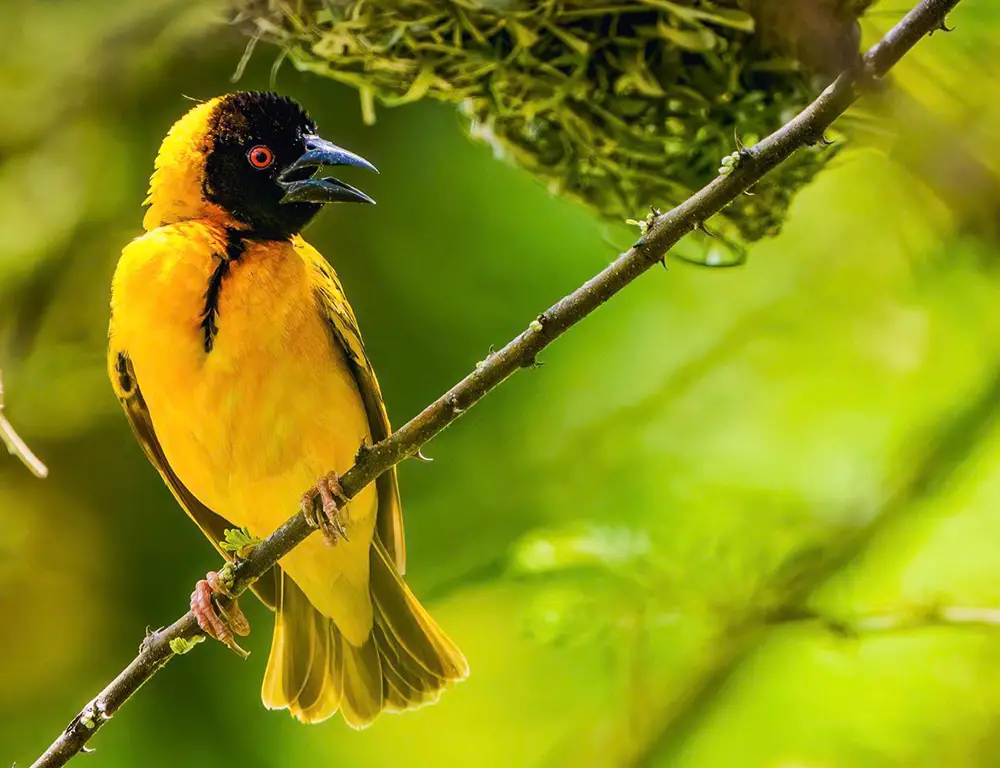
The vocalizations of the Village Weaver (Ploceus cucullatus) contribute to its rich social interactions and communication within its community.
These birds produce various sounds, including songs and calls, which play essential roles in mate attraction, territory defense, and coordination within the flock.
Here’s an overview of the vocalizations of Village Weavers:
Song
The song of the Village Weaver is a distinctive feature of its behavior, characterized by varied and complex vocalizations. These songs serve multiple purposes, including courtship displays, territorial defense, and communication within the flock.
Village Weavers generally favor two main types of songs:
- Fast Song: The fast song is typically associated with courtship displays, where males perform elaborate aerial maneuvers while singing rapidly.
This song is characterized by short, high-speed notes delivered quickly, creating an energetic and captivating display to attract females. - Slow Song: The slow song is often associated with the flock’s nest-building activities and other communal behaviors. It consists of more extended notes sung slower, conveying a sense of calm and cooperation among the birds.
This song may also serve as a form of communication during cooperative tasks, such as predator alarm calls or food sharing.
Variations and Dialects
Each Village Weaver develops unique variations of the basic song themes, resulting in diverse vocal dialects within the population. Age, social status, and environmental conditions can influence these variations.
Over time, the songs’ pitch, duration, and structure may change, reflecting the dynamic nature of communication within the flock.
Role in Social Behavior
The vocalizations of Village Weavers play a crucial role in social behavior and cohesion within the community. They use vocal signals to establish and maintain territories, attract mates, coordinate breeding activities, and alert each other to potential threats.
The songs and calls of Village Weavers create a vibrant auditory landscape, contributing to the overall dynamics of their social interactions.
Reproduction and Life Cycle of Village Weaver
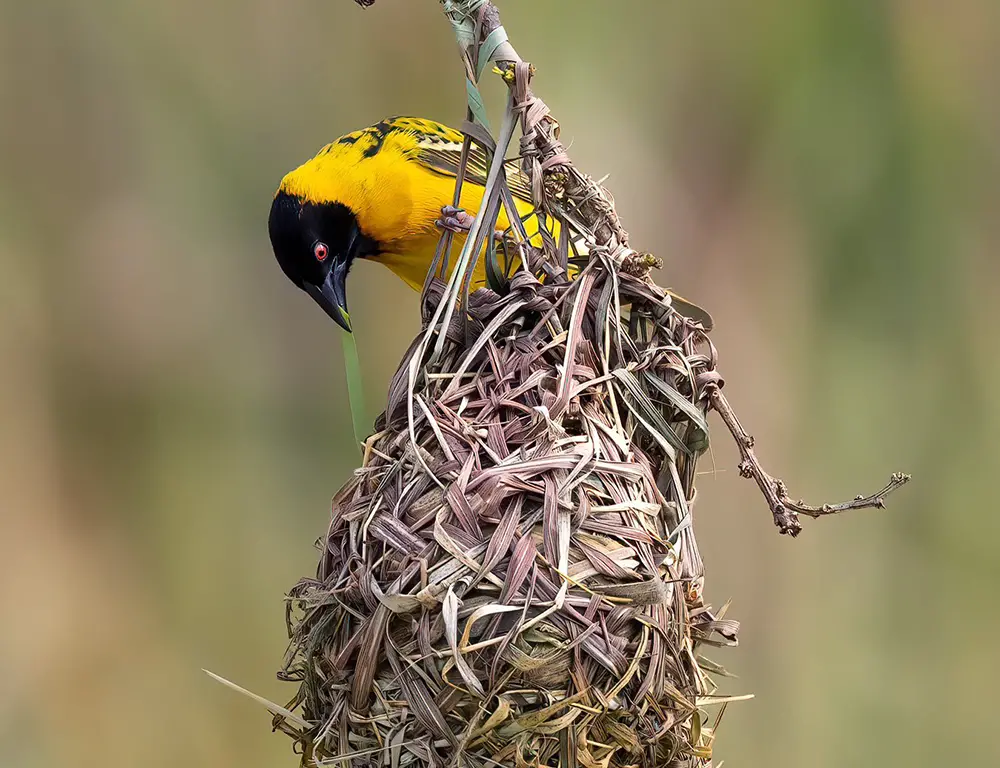
The reproduction and life cycle of the Village Weaver (Ploceus cucullatus) involve intricate behaviors and adaptations geared towards successful breeding and raising offspring.
Here’s an overview of their reproduction and life cycle:
Breeding Season
Village Weavers have a distinct breeding season that typically spans from June to December, although the exact timing may vary depending on local climate conditions.
Male Village Weavers undergo physiological and behavioral changes during this period to attract mates and establish breeding territories.
Courtship and Nest Building
Male Village Weavers engage in elaborate courtship displays to attract females. These displays often involve aerial acrobatics, singing, and the presentation of completed or partially completed nests.
Females evaluate males based on their physical condition, plumage coloration, and nest-building skills, as nests are essential indicators of male quality and parental investment.
Nest building is a critical aspect of reproduction for Village Weavers. Males construct intricately woven nests of grass, leaves, and other plant materials.
These nests are often suspended from tree branches and feature an entrance tunnel to a chamber where eggs are laid. Village Weavers are known to build multiple nests during a single breeding season, with each male constructing an average of 3 to 5 nests.
Egg Laying and Incubation
Once a female selects a mate and accepts a nest, she lays eggs inside the nest chamber. The typical clutch size ranges from 2 to 4 eggs, although this may vary depending on factors such as female age and environmental conditions.
Both males and females take turns incubating the eggs, with each parent sharing responsibility for keeping the eggs warm and protected from predators.
Hatching and Nestling Care
After an incubation period of about 11 to 14 days, the eggs hatch, and the nestlings emerge. Both parents feed and care for the nestlings, regurgitate food to feed them and remove waste from the nest.
The nestlings proliferate, developing feathers and gaining strength over several weeks.
Fledging and Independence
Once the nestlings reach a sufficient size and level of development, they flee from the nest and begin to explore their surroundings.
The fledglings continue to receive parental care and guidance as they learn essential skills such as foraging, predator avoidance, and social behavior. Over time, they become increasingly independent and eventually disperse to establish their territories and breeding sites.
Life Span and Reproductive Success
The life span of Village Weavers in the wild can vary, with individuals typically living for several years. Reproductive success is influenced by factors such as nest quality, food availability, and environmental conditions.
Successful breeding pairs may produce multiple broods in a single breeding season, contributing to the overall population dynamics of Village Weavers in their habitat.
Threats and Conservation Status of Village Weaver
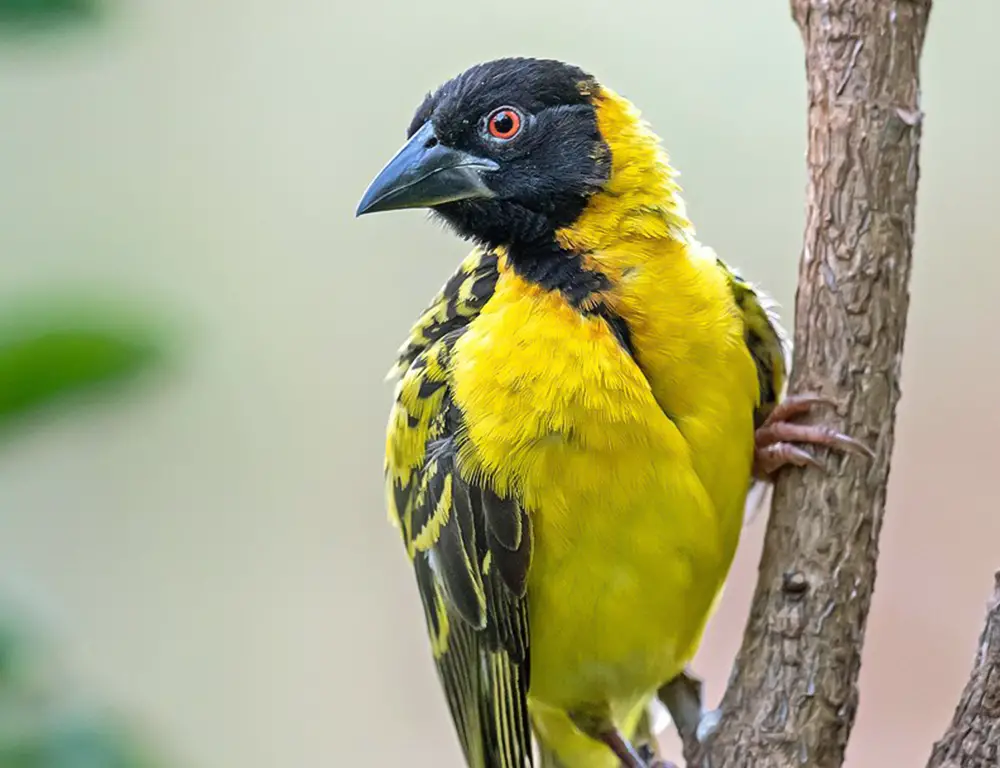
The Village Weaver (Ploceus cucullatus) faces various threats to its survival, primarily driven by human activities, habitat loss, and exploitation.
Despite being widespread across sub-Saharan Africa, populations of Village Weavers are declining in some regions due to these threats.
Here are the key threats and conservation measures concerning the Village Weaver:
Threats
- Habitat Loss and Degradation: Deforestation, urbanization, and agricultural expansion have led to significant loss and fragmentation of the Village Weaver’s natural habitat.
Destruction of nesting sites and foraging areas reduces breeding success and overall population viability. - Illegal Pet Trade: Village Weavers are often targeted for the illicit pet trade due to their striking appearance and unique nest-building behaviors.
The capture and trade of these birds for the pet market pose a significant threat to wild populations, particularly in areas where enforcement of wildlife protection laws is weak. - Pesticide Use: Agricultural pesticides, including insecticides and herbicides, can contaminate the food and water sources of Village Weavers, leading to direct mortality or sublethal effects such as reduced reproductive success and impaired immune function.
- Climate Change: Climate change indirectly threatens Village Weavers by altering weather patterns, disrupting breeding and migration cycles, and affecting food availability and nesting resources.
Increasing temperatures and changing precipitation patterns may exacerbate habitat loss and degradation, further impacting population dynamics.
Conservation Status and Measures
- Habitat Protection: Conservation efforts focus on protecting and restoring critical habitats for Village Weavers, including grasslands, savannahs, forest edges, and wetlands.
Establishing protected areas, nature reserves, and wildlife corridors helps safeguard essential nesting and foraging sites. - Law Enforcement: Strengthening law enforcement measures and implementing regulations against the illegal capture, trade, and possession of Village Weavers is crucial for curbing poaching and wildlife trafficking activities.
Increased penalties and public awareness campaigns aim to deter illegal wildlife trade and promote ethical behavior. - Community Engagement: Engaging local communities in conservation initiatives fosters stewardship of natural resources and promotes sustainable livelihoods.
Education programs, habitat restoration projects, and alternative income opportunities reduce dependence on natural resources and mitigate human-wildlife conflicts. - Research and Monitoring: Continued research on Village Weaver populations, ecology, and behavior provides valuable insights into their conservation needs and informs adaptive management strategies.
Monitoring programs track population trends, habitat quality, and threats, guiding conservation interventions and adaptive management decisions.
Conclusion
The Village Weaver captivates with its intricate nest-building prowess and vibrant plumage. This bird’s social structure and adaptability across Africa highlight its resilience against threats. However, habitat loss and climate change pose significant challenges to its survival.
Protecting their habitats is paramount for ensuring their continued existence. Studying creatures like the Village Weaver reveals nature’s complexity and beauty, reinforcing the importance of wildlife conservation.
Every species plays a vital role in our planet’s ecosystem, emphasizing the interconnectedness of all life forms. As we admire the Village Weaver’s intricate designs, let’s remember the profound impact of our efforts in preserving biodiversity.
In safeguarding these birds, we ultimately secure a brighter future for ourselves and the natural world.